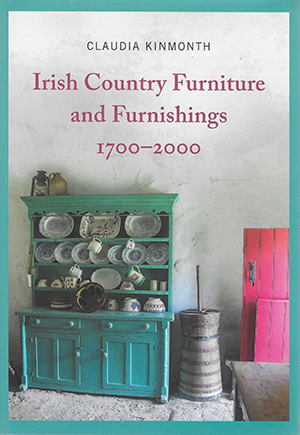IRISH COUNTRY FURNITURE AND FURNISHINGS, 1700–2000
Published in Book Reviews, Book Reviews, Issue 4 (July/August 2021), Reviews, Volume 29 CLAUDIA KINMONTH
CLAUDIA KINMONTH
Cork University Press
€39
ISBN 9781782054054
Reviewed by John Gibney
John Gibney is Assistant Editor with the RIA’s Documents on Irish Foreign Policy series and is the author of A short history of Ireland, 1500–2000 (Yale, 2017).
Irish country furniture and furnishings has its origins in Kinmonth’s Irish country furniture, 1700–1950, originally published in 1993. This, however, is far more than a second edition and is effectively a new book; the original text has been comprehensively rewritten, updated and expanded with new material, and with a greatly increased range of colour images replacing the black-and-white illustrations of the original. The chronological range has been extended and the book comes with an insightful new preface from one of Ireland’s most renowned social and economic historians, Louis Cullen, and is packaged in a beautifully produced, robust and easy-to-handle format.
This is more than a book about furniture and furnishings, as suggested in the title. It is more accurate to describe it as a study of Irish social history through domestic furniture and furnishings. Historians are often exhorted to expand the range of the sources they explore, and such exhortations may be observed more in the breach than in the observance: ‘material culture’ is a vast category but might end up consisting, in some accounts, of little more than a button or a letterhead. Where material culture can be categorised as furniture and furnishings, the possessions of the Irish aristocracy, and the artistic and practical endeavours associated with their lifestyles, inevitably dominate how these subjects are perceived prior to the twentieth century.
By way of contrast, Kinmonth’s book explores the furniture and furnishings of those lower down the social ladder; it is, often quite literally, a history from below. The book begins with an admirably wide-ranging and holistic introduction, followed by a sequence of chapters dealing with individual categories of furniture and furnishings: seats and stools, beds, dressers, tables, utensils, and even religious artefacts. It is extremely lucid and well written and is exceptionally well illustrated with over 400 images. Many of the photographs were taken by the author herself during the extensive fieldwork that underpins the book, which makes it an invaluable visual chronicle of Irish material culture; it is striking to see how often Irish furniture was painted and, indeed, decorated. As well as the fieldwork, the book also draws on a remarkable range of printed and manuscript sources, and Kinmonth makes especially good use of verse, fiction, memoir and contemporary illustrations (including work by artists such as Jack B. Yeats) to cast light on her subject.
Furniture and furnishings are often taken for granted (in life as well as in historical study), but these framed the lived reality of life in Ireland. What role did a chair or a bed play in a house? Why did they take certain forms? The emphasis here on vernacular outputs is refreshing, as is the way in which Kinmonth examines them in terms of wider human activities. While local craftsmen loom large here as the producers of furniture, they were, in turn, linked to wider trading and economic networks, as timber was generally imported in the eighteenth and nineteenth centuries, the period that accounts for most of what is examined here. She skilfully weaves together social, economic, cultural, religious and even culinary history into an illuminating whole, at the core of which is the creation and use of everyday objects that might otherwise escape the attention of historians.
Her categories of analysis are broad as well. Take, for example, ‘keeping holes’, or, as they were termed on the Aran Islands, cleibhí. These were architectural features rather than physical artefacts, being recesses in the walls beside the fireplaces of cottages and farmhouses, the purpose of which was to keep household goods like salt and tobacco dry. It was a response to a damp climate but also points to the social role played by a hearth—and, indeed, by tobacco—in rural Ireland. Kinmonth is alert to how the furniture and furnishings that she examines were linked to society at large. Straw rope or súgán was commonly used to make seats and chairs, but a tool such as a ‘thraw-hook’, which was used to twist the straw into rope, points to something else. Its name is derived from Scotland and its usage indicates cultural exchange, whether by colonisation or migration. She is also alert to how the ripple effects of social and technological change shaped the domestic environment. Rural electrification, for example, transformed religious artefacts by allowing for the incorporation of votive lights to permanently illuminate devotional images of the Sacred Heart (and presumably, in the 1960s, images of JFK).
These are merely two examples among hundreds to be found in what is an excellent and very accessible book that will surely appeal to a diverse readership. The history of ‘everyday life’ remains fallow ground for Irish historians. Kinmonth’s exploration of the materiality of Irish life through the titular furniture and furnishings reveals a great deal about how Irish people in previous centuries adapted to, and were shaped by, their physical environments. In doing so it reveals a great deal about how they actually lived their lives, in ways that will surely resonate with anyone who has ever set foot inside a dwelling place. This is an endlessly fascinating publication, beautifully produced at a very good price, and one that can and should be widely read, and revisited again and again.
















